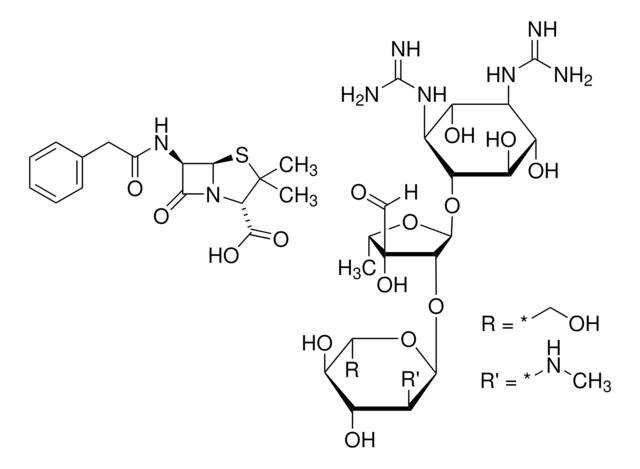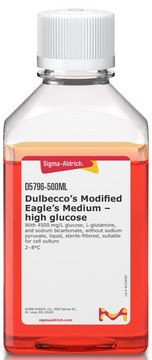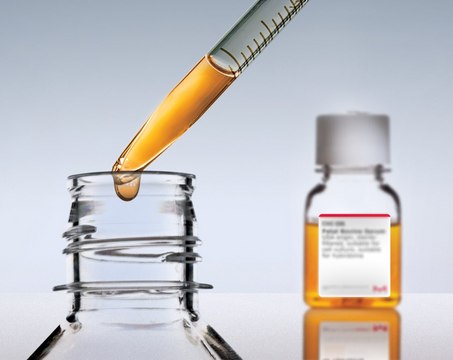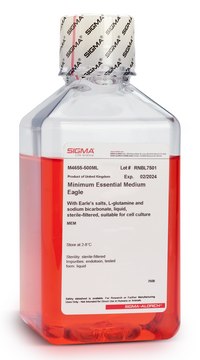推荐产品
产品名称
RPMI-1640 培养基, With L-glutamine and sodium bicarbonate, liquid, sterile-filtered, suitable for cell culture
质量水平
无菌性
sterile-filtered
表单
liquid
技术
cell culture | mammalian: suitable
杂质
endotoxin, tested
组分
NaHCO3: yes
phenol red: yes
sodium pyruvate: no
HEPES: no
L-glutamine: yes
运输
ambient
储存温度
2-8°C
正在寻找类似产品? 访问 产品对比指南
一般描述
应用
推荐
相关产品
通常也和此产品一起购买
储存分类代码
12 - Non Combustible Liquids
WGK
WGK 1
闪点(°F)
Not applicable
闪点(°C)
Not applicable
法规信息
Which document(s) contains shelf-life or expiration date information for a given product?
If available for a given product, the recommended re-test date or the expiration date can be found on the Certificate of Analysis.
Does Product R8758, RPMI-1640 Medium, contain glucose?
RPMI contains glucose at 2 g/L. The complete formulation of RPMI and other classical media formulations can be found on the Cell Culture Web Page.
Can I add the glutamine dipeptide to Product R8758, RPMI-1640 Medium?
This formulation of RPMI already contains L-glutamine at 0.3 g/L. It does not require further supplementation with L-glutamine or the L-glutamine dipeptide (Product No. G8541).
Does Product R8758, RPMI-1640 Medium, contain HEPES?
There is no HEPES in this formulation of RPMI. We do offer RPMI containing HEPES as Product No's. R5886 and R4130. The formulation of RPMI and other classical media can be found on the Cell Culture Web Page.
Can Product R8758, RPMI-1640 Medium, be frozen?
We do not recommend freezing cell culture media. A precipitate may form upon thawing. Also, this can cause a loss of amino acids, which may yield low cell growth.
Does Product R8758, RPMI-1640 Medium, contain phenol red?
This media contains phenol red. The formulation of RPMI and other classical media can be found on the Cell Culture Web Page.
How do I get lot-specific information or a Certificate of Analysis?
The lot specific COA document can be found by entering the lot number above under the "Documents" section.
How do I find price and availability?
There are several ways to find pricing and availability for our products. Once you log onto our website, you will find the price and availability displayed on the product detail page. You can contact any of our Customer Sales and Service offices to receive a quote. USA customers: 1-800-325-3010 or view local office numbers.
What is the Department of Transportation shipping information for this product?
Transportation information can be found in Section 14 of the product's (M)SDS.To access the shipping information for this material, use the link on the product detail page for the product.
My question is not addressed here, how can I contact Technical Service for assistance?
Ask a Scientist here.
实验方案
Preparation for biodegradable nanoparticles and their use in transfection protocols .
Step-by-step protocol for ADCC assays using cryopreserved NK effector cells including tips and tricks, assay development, and data analysis methods.
Learn how to perform cell migration assays in vitro using Millicell® hanging cell culture inserts and the suspension T-cell lines Jurkat and primary CD4+ cells. Monitor migration by flow cytometry and EZ-MTT assays.
相关内容
Learn how to use our cell culture tested, ready-to-use MilliShot™ single dose antibiotic solutions, conveniently packaged in one-time use vials.
Our broad range of the most trusted tools for cell culture includes stringently sourced and tested FBS, established media formulations, and sterile labware. Cutting-edge techniques using stem cells and 3D matrices are enabled by organoids, hydrogels, culture scaffolds, and bioinks for 3D bioprinting.
我们的科学家团队拥有各种研究领域经验,包括生命科学、材料科学、化学合成、色谱、分析及许多其他领域.
联系技术服务部门





